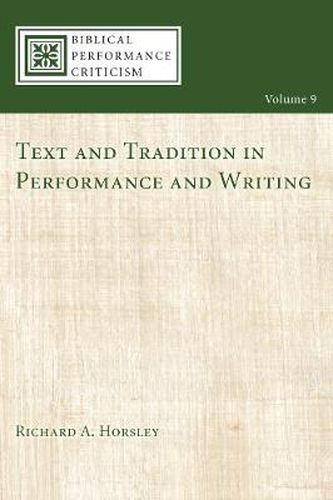Readings Newsletter
Become a Readings Member to make your shopping experience even easier.
Sign in or sign up for free!
You’re not far away from qualifying for FREE standard shipping within Australia
You’ve qualified for FREE standard shipping within Australia
The cart is loading…






This title is printed to order. This book may have been self-published. If so, we cannot guarantee the quality of the content. In the main most books will have gone through the editing process however some may not. We therefore suggest that you be aware of this before ordering this book. If in doubt check either the author or publisher’s details as we are unable to accept any returns unless they are faulty. Please contact us if you have any questions.
Embedded in modern print culture, biblical scholars have been projecting the assumptions and concepts of print culture onto the texts they interpret. In the ancient world from which those texts originate, however, literacy was confined to only a small number of educated scribes. And, as recent research has shown, even the literate scribes learned texts by repeated recitation, while the nonliterate ordinary people had little if any direct contact with written scrolls. The texts that had taken distinctive form, moreover, were embedded in a broader and deeper cultural repertoire cultivated orally in village communities as well as in scribal circles. Only recently have some scholars struggled to appreciate texts that later became biblical in their own historical context of oral communication. Exploration of texts in oral performance–whether as scribal teachers’ instruction to their proteges or as prophetic speeches of Jesus of Nazareth or as the performance of a whole Gospel story in a community of Jesus-loyalists–requires interpreters to relinquish their print-cultural assumptions. Widening exploration of texts in oral performance in other fields offers exciting new possibilities for allowing those texts to come alive again in their community contexts as they resonated with the cultural tradition in which they were embedded.
$9.00 standard shipping within Australia
FREE standard shipping within Australia for orders over $100.00
Express & International shipping calculated at checkout
This title is printed to order. This book may have been self-published. If so, we cannot guarantee the quality of the content. In the main most books will have gone through the editing process however some may not. We therefore suggest that you be aware of this before ordering this book. If in doubt check either the author or publisher’s details as we are unable to accept any returns unless they are faulty. Please contact us if you have any questions.
Embedded in modern print culture, biblical scholars have been projecting the assumptions and concepts of print culture onto the texts they interpret. In the ancient world from which those texts originate, however, literacy was confined to only a small number of educated scribes. And, as recent research has shown, even the literate scribes learned texts by repeated recitation, while the nonliterate ordinary people had little if any direct contact with written scrolls. The texts that had taken distinctive form, moreover, were embedded in a broader and deeper cultural repertoire cultivated orally in village communities as well as in scribal circles. Only recently have some scholars struggled to appreciate texts that later became biblical in their own historical context of oral communication. Exploration of texts in oral performance–whether as scribal teachers’ instruction to their proteges or as prophetic speeches of Jesus of Nazareth or as the performance of a whole Gospel story in a community of Jesus-loyalists–requires interpreters to relinquish their print-cultural assumptions. Widening exploration of texts in oral performance in other fields offers exciting new possibilities for allowing those texts to come alive again in their community contexts as they resonated with the cultural tradition in which they were embedded.